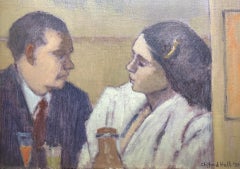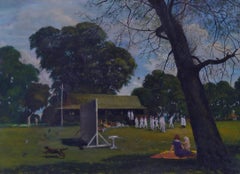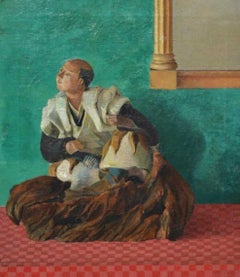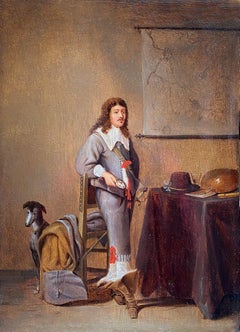Want more images or videos?
Request additional images or videos from the seller
1 of 5
20th Century English SchoolThree Ages of Man, 20th Century Oil on Board Figurative Painting
$716.88List Price
About the Item
- Creator:20th Century English School
- Dimensions:Height: 10.25 in (26.04 cm)Width: 16.75 in (42.55 cm)
- More Editions & Sizes:1 of 1Price: $717
- Medium:
- Movement & Style:
- Period:
- Framing:Framing Options Available
- Condition:
- Gallery Location:London, GB
- Reference Number:1stDibs: LU52412887912
About the Seller
5.0
Vetted Professional Seller
Every seller passes strict standards for authenticity and reliability
Established in 2007
1stDibs seller since 2014
83 sales on 1stDibs
Typical response time: 4 hours
Authenticity Guarantee
In the unlikely event there’s an issue with an item’s authenticity, contact us within 1 year for a full refund. DetailsMoney-Back Guarantee
If your item is not as described, is damaged in transit, or does not arrive, contact us within 7 days for a full refund. Details24-Hour Cancellation
You have a 24-hour grace period in which to reconsider your purchase, with no questions asked.Vetted Professional Sellers
Our world-class sellers must adhere to strict standards for service and quality, maintaining the integrity of our listings.Price-Match Guarantee
If you find that a seller listed the same item for a lower price elsewhere, we’ll match it.Trusted Global Delivery
Our best-in-class carrier network provides specialized shipping options worldwide, including custom delivery.You May Also Like
The tramp and his daughter oil on board painting modernism art
Located in Barcelona, Barcelona
Oil measures 70x50 cm.
Frame measures 83x63 cm.
Painter of landscapes and figures, in whose characterization he deepens psychologically capturing the character, Albert
Roca has won...
Category
1990s Modern Portrait Paintings
Materials
Oil, Board
$903 Sale Price
50% Off
H 27.56 in W 19.69 in
A town 11. Contemporary figurative mixed media artwork, Landscape, Polish art
By Dominika Stawarz-Burska
Located in Warsaw, PL
Contemporary figurative mixed media on cardboard painting by Polish artist Dominika Stawarz-Burska. Artwork has characteristical glossy finish to it which resembles surface of cerami...
Category
2010s Modern Figurative Paintings
Materials
Mixed Media, Cardboard, Oil
$1,083
H 12.21 in W 11.82 in
Woman at Rest with Mandolin oil on board painting modernism art
Located in Barcelona, Barcelona
Oil measures 46x65 cm.
Frame measures 69x87 cm.
Technical Sheet:
- Title: Woman at Rest with Mandolin
- Artist: Albert Roca (1945)
- Technique: Oil on board
- Dimensions with...
Category
1990s Modern Figurative Paintings
Materials
Oil, Board
$842 Sale Price
56% Off
H 18.12 in W 25.6 in
Cityscape Mid-20th Century Modern Social Realism American Scene Regionalism WPA
Located in New York, NY
Cityscape Mid-20th Century Modern Social Realism American Scene Regionalism WPA
Samuel Thal (1903 to 1964)
"Cityscene"
12 x 16 inches
Oil on board, c. 1940s
Signed verso
Framed: 19...
Category
1940s American Modern Figurative Paintings
Materials
Board, Oil
Modern Georgian Art by Grigol Chirinashvili - Autumn in Kakheti, Georgia
Located in Paris, IDF
Oil on cardboard
Grigol Chirinashvili was a Georgian artist (1918-1999) who lived and worked in Tbilisi, Georgia. He graduated from the National Academy of Arts in Tbilisi and the A...
Category
2010s Modern Figurative Paintings
Materials
Cardboard, Oil
$8,000
H 27.17 in W 15.36 in D 1.58 in
Modern Georgian Art by Grigol Chirinashvili - Meat Grinder
Located in Paris, IDF
Oil on cardboard
Grigol Chirinashvili was a Georgian artist (1918-1999) who lived and worked in Tbilisi, Georgia. He graduated from the National Academy of Arts in Tbilisi and the A...
Category
2010s Modern Figurative Paintings
Materials
Cardboard, Oil
$6,000
H 26.38 in W 17.33 in D 1.58 in
Modern Georgian Art by Grigol Chirinashvili - Harvest
Located in Paris, IDF
Oil on cardboard
Grigol Chirinashvili was a Georgian artist (1918-1999) who lived and worked in Tbilisi, Georgia. He graduated from the National Academy of Arts in Tbilisi and the A...
Category
2010s Modern Figurative Paintings
Materials
Cardboard, Oil
$8,000
H 26.38 in W 19.69 in D 1.58 in
Modern Georgian Art by Grigol Chirinashvili - Depo Workers
Located in Paris, IDF
Oil on cardboard
Grigol Chirinashvili was a Georgian artist (1918-1999) who lived and worked in Tbilisi, Georgia. He graduated from the National Academy of Arts in Tbilisi and the A...
Category
2010s Modern Figurative Paintings
Materials
Cardboard, Oil
$6,000
H 18.12 in W 24.81 in D 1.58 in
Modern Georgian Art by Grigol Chirinashvili - The Landscape
Located in Paris, IDF
Oil on cardboard
Grigol Chirinashvili was a Georgian artist (1918-1999) who lived and worked in Tbilisi, Georgia. He graduated from the National Academy of Arts in Tbilisi and the A...
Category
2010s Modern Figurative Paintings
Materials
Cardboard, Oil
$10,000
H 9.85 in W 13.78 in D 1.58 in
"Industrial Cityscape, Chicago" WPA Modernism Mid-Century Cityscape 20th Century
By Aaron Bohrod
Located in New York, NY
"Industrial Cityscape, Chicago" WPA Modernism Mid-Century Cityscape 20th Century
Aaron Bohrod (American 1907 – 1992)
Industrial Cityscape
20 x 16 inches
Oil on board
Signed lower ri...
Category
1930s American Modern Landscape Paintings
Materials
Oil, Board
More From This Seller
View AllA Cafe in Madrid, Oil on Board Painting, Signed and Dated 1950, English Artist
By Clifford Hall
Located in London, GB
Oil on board, signed and dated '50 bottom right, entitled on reverse
Image size: 13 1/2 x 9 1/2 inches (34.5 x 23 cm)
Original frame
Exhibitions
1989, Belgrave Gallery, 22 Mason's Yard, Duke Street, St. James', London SW1 'Clifford Hall (1904-1973) 15th June - 14th July, no.12.
Clifford Hall
Clifford Hall was born in Wandsworth in 1904, and spent his youth in nearby Richmond upon Thames...
Category
Mid-20th Century Modern Figurative Paintings
Materials
Oil, Board
The Cricket Match, Mid 20th Century British School Oil
Located in London, GB
British School
Mid 20th Century
The Cricket Match
Oil on board
Image size: 18 x 24 inches (46 cm x 61 cm)
Category
20th Century Figurative Paintings
Materials
Oil, Board
Figurine, 20th Century Oil on Board Signed Painting, Contemporary Frame
Located in London, GB
Mayer
20th Century
Figurine
Oil on board, signed lower right
Image size: 16 x 13 inches
Contemporary frame
Category
20th Century Figurative Paintings
Materials
Oil, Board
Soldier in an Interior, Early 17th Century Dutch Oil
Located in London, GB
Pieter Symonsz Potter
Dutch 1600 - 1652
Soldier in an Interior
Oil on oak panel, red seal to reverse
Image size: 15 x 10 3/4 inches
Dutch Ebonised frame
Bathed in a well lit roo...
Category
Early 17th Century Old Masters Portrait Paintings
Materials
Oil, Board
Turkish Garden Party, Early 19th Century Oil
Located in London, GB
A Turkish Garden Party
Early 19th Century
Oil on board
Image size: 16 x 20 inches
Contemporary frame
Category
Early 19th Century Figurative Paintings
Materials
Oil, Board
Lower Chedworth
Located in London, GB
English School
Lower Chedworth
20th Century
Oil on board, signed lower right
Image size: 19 1/2 x 23 1/2 inches (49.5 x 59.5 cm)
Original frame
In this painting, the winding countr...
Category
20th Century Figurative Paintings
Materials
Oil, Board



